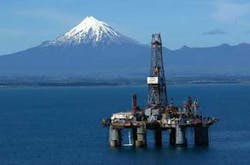New Zealand operators face technical demands
In offshore circles, New Zealand never will be confused with the North Sea or Gulf of Mexico, and while the prospect of a giant discovery may be slimmer than that for the more celebrated offshore theaters, the tiny nation has more than its share of technically demanding projects.
When it comes online in October, the OMV-operated Maari field off the South Taranaki coast will become the second offshore New Zealand field to begin production in a little more than a year.
The fasttracked Tui field, operated by Australian Worldwide Exploration Limited (AWE), came on stream in July 2007, remarkably going from discovery to production in four years. Tui may very well set the world standard for offshore fasttrack development by recouping $245 million of costs in three months, effectively enabling operator AWE to eliminate all corporate debt.
With fabled Mt. Taranaki standing watch, theOcean Bounty drills an exploration well early in the Tui campaign for then operator New Zealand Overseas Petroleum (NZOP). Photo courtesy of NZOP.
Considering downhole difficulties that make drilling offshore New Zealand no exercise for the faint of heart, fast tracking a field offshore the Taranaki coast is a world-class technical achievement.
The Pohokura field, which Shell Exploration New Zealand Ltd. completed this summer, illustrates the inherent technological challenges offshore New Zealand. With some of the longest ERD wells ever drilled in Southeast Asia, Pohokura comprises one injector and three production wells from an onshore location and five producers, including one dual lateral, from a jackup rig.
Pohokura wells are characterized by tortuous well paths through reactive and dispersive shales. This field certainly is not alone, as wells throughout the New Zealand coast are fraught with coal seams, volcanic activity, highly pressurized formations, and compartmentalized reservoirs that combine to make the drilling environment here very complex, indeed. One local industry insider said if an operator encounters the limestone formations typically found around 13,120 ft (4,000 m) “they could lose everything,” which forces most to sidetrack.
Nevertheless, major and independent operators continue to pour investments into the twin islands. Operators already are beginning to take a keen interest in newly opened acreage off the South Basin, where those already committed are expected to spend upwards of $938 million over the next decade.
“The intensity of work proposed for the Great South Basin is unprecedented in New Zealand’s history and will effectively double the amount of investment in oil and gas exploration here over the next few years,” Associate Energy Minister Harry Duynhoven said earlier this year.
New era in deepwater multizone isolation
Weatherford International says its recently introduced 7-in. (18-cm) ERC expanded reservoir completion system is ideally suited for isolating the multiple zones intrinsic of many deepwater applications.
The 7-in. ERC system, representing the next generation of expandable reservoir completion technology, follows the introduction of the Weatherford ESS expandable sand screen more than a decade ago. Today, there are more than 550 installations of the screens worldwide. Owing to ever-increasing reservoir complexity, the 7-in. ERC system (in conjunction with the expandable sand screens) has now been deployed.
According to Weatherford, the ERC, developed in conjunction with a major operator, employs a modular assembly of components to segregate zones in an open-hole completion, thereby eliminating the need to case, cement and perforate the target zone. This capacity not only eliminates costs, but also retains the multizone control of a cased hole.
In the deepwater, multizone completions allow operators to initiate production with a single and longer wellbore and eliminates multiple wells. With the ERC, operators can selectively manage multiple zones, thus enhancing the viability of many deepwater fields, Weatherford says. The system has been used worldwide, including deepwater applications in West Africa and elsewhere.
According to its developer, the system’s 7-in. diameter supports the high production potential of open-hole completions, while providing ample room for the installation of intelligent hardware required in managing multiple production and injection zones over the life of the well.
RFID-activated cleanup tools
The industry’s first circulating valve activated by radio frequency identification (RFID) technology for drilling and completion wellbore cleanup applications will undergo field trials later this year with commercial deployment envisioned in 1Q 2009.
Developed by the Specialized Tools unit of Houston-based M-I Swaco under a licensing agreement with iiiTec, the IntelliForce CCV opens and closes via a small RFID activation tag that is incorporated into the well fluid and pumped through the tool. The company says RFID-activated circulating valves have many advantages over typical ball or flow-operated tools and hold the potential to save operators millions of dollars annually in rig downtime alone.
Each activation tag is individually program-med to initiate a specific operation, such as opening or closing ports, for a particular tool. The IntelliForce CCV contains a power source, an electro-hydraulic system and a sliding sleeve. When the tag passes through the tool, a code is transmitted that activates the hydraulic system to move the sleeve to open or close the circulating ports.
The tool is designed to perform at least 20 open/close cycles in one trip, with the total number of cycles limited only by the battery life.
The IntelliForce CCV is designed for use in a drilling bottom hole assembly above a turbine or mud motor to periodically increase circulating rates during the drilling operation for improved hole cleaning and cuttings removal, which is particularly beneficial in horizontal and extended reach wells. Further, the technology is engineered for employment in the wellbore clean-up string to boost annular velocity and achieve turbulent flow for enhanced debris removal and for any drilling assembly being used for spotting of lost circulation material pills.
The tool is expected to be available for commercial use in the first quarter of 2009.






